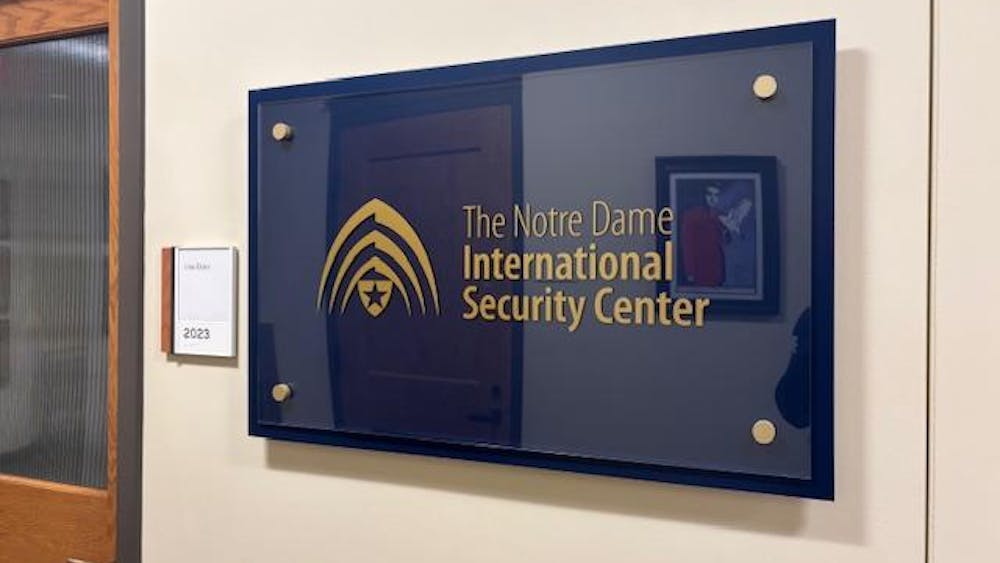One in three adult women and one in six adult men report having experienced some form of violence from an intimate partner in their lifetime, Elisabeth Vasko, associate professor of theology at Duquesne University, said in her keynote address for the Time to Heal dinner. Intimate relationship violence can happen to anyone, no matter age, background, race, orientation or gender, Vasko said,.
“How can we keep letting this happen in our communities?” Vasko asked at the second annual dinner.
In support of the survivors in the Notre Dame, Holy Cross and Saint Mary’s community, students, faculty, staff and community members convened Wednesday in the Dahnke Ballroom to commemorate Relationship Violence Awareness month.
The dinner, coordinated by the Gender Relations Center (GRC), serves as an opportunity to show support for people who have been affected by power-based personal violence, John Johnstin, assistant director for outreach, student leadership and assessment at the GRC said.
Mannequins in a black dress, Notre Dame athletic apparel and jeans and a tie-dye t-shirt, among other outfits, were accompanied by plaques with the words of survivors as part of the “What Were You Wearing?” survivor art installation. Mary Wyandt-Hiebert of the University of Arkansas and Jen Brockman of the University of Kansas created the installation in 2013 based Mary Simmerling’s poem “What I Was Wearing.” Brockman and Wyandt-Hierbert interviewed survivors, asked them what they were wearing when they were assaulted and recreated what the survivors described.
The installation travels the world, using the same quotes from survivors but allowing institutions to take their own donations for clothing, Johnstin said.
“Each [display piece] is different but courageously offers insight to how we both individually and collectively can become beacons of hope and compassion.” Christine Gebhardt, director of the GRC, said. “Our call is to carry these stories with them. By sharing stories and being present we send a message that when one of us is harmed, we all are impacted.”
Vasko recently published “Beyond Apathy: A Theology for Bystanders.” Throughout her presentation, Vasko stressed the importance of asking uncomfortable questions in creating change.
“Intimate partner violence can take many different forms,” she said. “Irrespective of the circumstances, healing is hard. Despite our best intentions, as communities, we continue to miss this point.”
Intimate partner violence takes place when a person believes they are “entitled to control their partner,” Vasko said. This may mean a partner is isolated from friends and family, controlled financially, blamed for violent behavior or experiences physical or sexual violence. The statistical likelihood of intimate partner violence can vary by a person’s gender, ethnicity, orientation and ability. As a society, we are taught to accept sexual violence through everyday materials from Disney movies to ad campaigns, which makes it difficult to recognize intimate partner violence, she said.
“Boys will be taught that a certain amount of threat is an acceptable expression of masculinity,” Vasko said.
To enact social change, Vasko said, one must learn to critique such norms of society. She endorsed adopting an intersectional approach to violence intervention by taking race and sexuality, gender, orientation and class into consideration, and including people of color and the LGBTQ community in the conversation. Societal change won’t come quickly or easily, she said, and it is imperative that those seeking change stay in the conversation for a long-term solution rather than a quick fix.
“Because this kind of violence that you’re talking about this month is so hidden, you have to reorganize your time to be able to notice it,” Vasko said. “ … Compassion takes time.”
The final event for Relationship Violence Awareness month is the Fall Festival, which will take place on Oct. 30 from 2-4 p.m. on Fieldhouse Mall.
Read More
Trending









